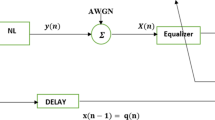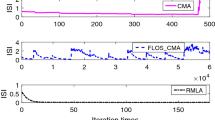Abstract
In this paper, I propose for the noisy, real, and two independent quadrature carrier case, an approximated closed-form expression for the achievable minimum mean square error (MSE) performance obtained by blind equalizers where the error that is fed into the adaptive mechanism which updates the equalizer’s taps can be expressed as a polynomial function of the equalized output of order three like in Godard’s algorithm. The proposed closed-form expression for the achievable MSE is based on the step-size parameter, on the equalizer’s tap length, on the channel power, on the signal to noise ratio (SNR), on the nature of the chosen equalizer, and on the input signal statistics. Since the channel power is measurable or can be calculated if the channel coefficients are given, there is no need anymore to carry out any simulation with various step-size parameters, different values for the signal to noise ratio (SNR) and equalizer’s tap length for a given equalization method, and input signal statistics in order to find the MSE performance in the convergence state.
Similar content being viewed by others
References
Feng C., Chi C.: Performance of cumulant based inverse filters for blind deconvolution. IEEE Trans. Signal Process. 47(7), 1922–1935 (1999)
Im G.H., Won H.C.: RF interference suppression for VDSL system. IEEE Trans. Consum. Electron. 47(4), 715–722 (2001)
Nikias, C.L., Petropulu, A.P. (eds): Higher-Order Spectra Analysis a Nonlinear Signal Processing Framework, Chapter 9, pp. 419–425. Prentice-Hall, Engle-wood Cliffs (1993)
Godard D.N.: Self recovering equalization and carrier tracking in two-dimenional data communication system. IEEE Trans. Commun. 28(11), 1867–1875 (1980)
Sato Y.: A method of self-recovering equalization for multilevel amplitude-modulation systems. IEEE Trans. Commun. 23, 679–682 (1975)
Pinchas, M.: A MSE optimized polynomial equalizer for 16QAM and 64QAM constellation. Signal Image Video Process. Oct. 2009; doi:10.1007/s11760-009-0138-z
Bellini, S.: Bussgang techniques for blind equalization. In: IEEE Global Telecommunication Conference Records, pp. 1634–1640, December 1986
Bellini S.: Blind equalization. Alta Frequenza. 57, 445–450 (1988)
Pinchas M., Bobrovsky B.Z.: A maximum entropy approach for blind deconvolution. Signal Process. (Eurasip) 86, 2913–2931 (2006)
Haykin, S.: Blind deconvolution. In: Haykin S. (eds) Adaptive Filter Theory, Chapter 20. Prentice-Hall, Englewood Cliffs (1991)
Zeng H.H., Tong L., Johnson C.R. Jr: Relationships between the constant modulus and Wiener receivers. IEEE Trans. Inform. Theor. 44, 1523–1538 (1998)
Schniter P., Johnson C.R. Jr: Bounds for the MSE performance of constant modulus estimators. IEEE Trans. Inform. Theor. 46, 2544–2560 (2000)
Regalia P.A., Mboup M.: Properties of some blind equalization criteria in noisy multi-user environments. IEEE Trans. Signal Process. 49, 3112–3122 (2001)
Gi-Hong Im., Park C.J., Won H.C.: A blind equalization with the sign algorithm for broadband access. IEEE Comm. Lett. 5(2), 70–72 (2009)
Lazaro M., Santamaria I., Erdogmus D., Hild K.E., Pantaleon C., Principe J.C.: Stochastic blind equalization based on pdf fitting using parzen estimator. IEEE Trans. Signal Process. 53(2), 696–704 (2005)
Shalvi O., Weinstein E.: New criteria for blind deconvolution of nonminimum phase systems (channels). IEEE Trans. Inf. Theor. 36(2), 312–321 (1990)
Nandi, A.K. (eds): Blind Estimation Using Higher-Order Statistics, Chapter 2, pp. 66. Kluwer Academic, Boston (1999)
Pinchas, M.: A new closed approximated formed expression for the achievable residual ISI obtained by adaptive blind equalizers for the noisy case. In: 2010 IEEE International Conference on Wireless Communications, Networking and Information Security (WCNIS2010), June 25–27, 2010, Beijing, China
Pinchas M.: A closed approximated formed expression for the achievable residual intersymbol interference obtained by blind equalizers. Signal Process. J. (Eurasip) 90(6), 1940–1962 (2010). doi:10.1016/j.sigpro.2009.12.014
Fiori S.: A contribution to (neuromorphic) blind deconvolution by flexible approximated Bayesian estimation. Signal Process. (Eurasip) 81, 2131–2153 (2001)
Godfrey R., Rocca F.: Zero memory non-linear deconvolution. Geophys. Prospect. 29, 189–228 (1981)
Shalvi O., Weinstein E.: Super-exponential methods for blind deconvolution. IEEE Trans. Inf. Theor. 39(2), 312–321 (1993)
Author information
Authors and Affiliations
Corresponding author
Rights and permissions
About this article
Cite this article
Pinchas, M. A novel expression for the achievable MSE performance obtained by blind adaptive equalizers. SIViP 7, 67–74 (2013). https://doi.org/10.1007/s11760-011-0208-x
Received:
Revised:
Accepted:
Published:
Issue Date:
DOI: https://doi.org/10.1007/s11760-011-0208-x




